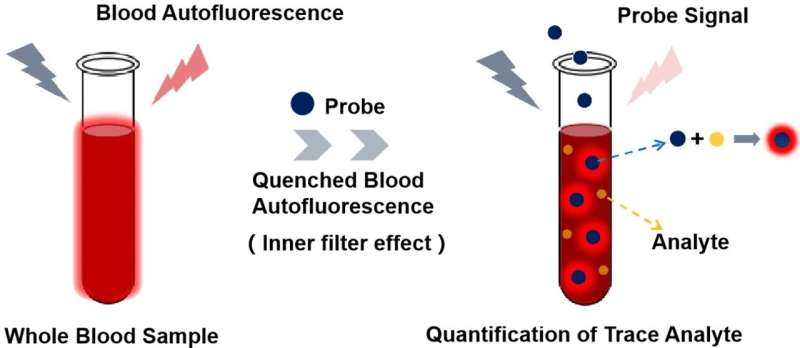This article has been reviewed according to Science X's editorial process and policies. Editors have highlighted the following attributes while ensuring the content's credibility:
fact-checked
peer-reviewed publication
trusted source
proofread
New fluorescence probe enables the quantification of trace analytes in whole blood

Quick assessment of trace blood components in untreated blood samples is possible with fluorescence tests but, in practice, blood's strong autofluorescence interferes with the analysis. In the journal Angewandte Chemie International Edition, a research team has now introduced a novel fluorescence probe that quenches this autofluorescence and precisely quantifies traces of hydrogen sulfide, which is an important signal molecule.
Some blood components are present in extremely low concentrations but are anything but unimportant. For example, the toxic gas hydrogen sulfide H2S, which smells of rotten eggs, is an important messenger molecule in the body. It is, among other things, involved in regulating circulation.
Patients with cardiovascular diseases usually have a reduced H2S concentration in their blood, whereas patients with colon cancer often have elevated levels. The quantification of this and other trace components are correspondingly helpful in forming a diagnosis, and for the investigation of physiological and pathological relationships.
Fluorescence tests are especially powerful in the analysis of biomolecules. They are inexpensive, uncomplicated, highly sensitive, and can be used for real-time measurements. The problem is that trace components cannot be detected in whole blood samples because blood itself strongly fluoresces, overwhelming weaker signals. Whole blood is therefore centrifuged and only the plasma is analyzed. However, this reduces the concentrations of unstable components and gas molecules, yielding inaccurate results.
A team led by Hongwen Liu and Ronghua Yang at Hunan Normal University (Changsha, China) has now developed a novel technique for fluorescence tests that can successfully quantify H2S in whole blood. The trick is that the fluorescence probe itself almost completely quenches the interfering autofluorescence of the blood. The fluorescence dye very strongly absorbs the light that is given off by the autofluorescence of blood components.
The fluorescence dye used is based on borodipyrromethene (BODIPY) that has been modified by the addition of two molecular fragments that "recognize" H2S. The presence of H2S activates the probe and it begins to fluoresce. Because the autofluorescence of the blood remains quenched, the background fluorescence remains very low and does not interfere.
Fluorescence tests using the new probe on whole blood samples from patients with cardiovascular diseases verified their reduced H2S levels. Tests on mice with colon cancer showed, also as expected, elevated blood H2S concentrations.
In addition, red blood cells from mice were treated with allicin. Allicin is the fragrant compound in garlic that is also responsible for its positive medicinal effects, such as reducing blood pressure. The team was able to use their new probe to demonstrate that allicin triggers the formation of H2S in red blood cells.
The researchers hope to use this strategy to develop additional probes for other trace analytes in whole blood.
More information: Zhiyang Yuwen et al, A Quencher‐Based Blood‐Autofluorescence‐Suppression Strategy Enables the Quantification of Trace Analytes in Whole Blood, Angewandte Chemie International Edition (2023). DOI: 10.1002/anie.202302957
Journal information: Angewandte Chemie International Edition
Provided by Wiley





















